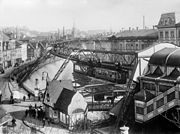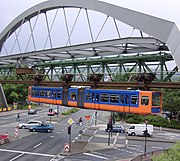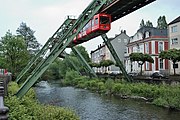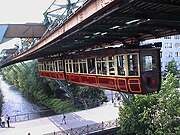| Revision as of 09:38, 27 August 2013 editMartinvl (talk | contribs)Autopatrolled, Pending changes reviewers, Rollbackers18,715 edits Infobox← Previous edit | Revision as of 00:29, 29 August 2013 edit undoMartinvl (talk | contribs)Autopatrolled, Pending changes reviewers, Rollbackers18,715 edits Adding route planNext edit → | ||
| Line 14: | Line 14: | ||
| |operator=Wuppertaler Stadtwerke (WSW) | |operator=Wuppertaler Stadtwerke (WSW) | ||
| |}} | |}} | ||
| {| {{Railway line header}} | |||
| {{BS-header|Wuppertal Suspension Railway<br />(''Wuppertaler Schwebebahn'')||#003399||}} | |||
| {{BS-table}} | |||
| {{BS|uhKDSTa|||Depot and turning loop}} | |||
| {{BS|uhBHF|0.0|Oberbarmen}} | |||
| {{BS|uhHST|0.7|Wupperfeld}} | |||
| {{BS|uhHST|1.3|Werther Brücke}} | |||
| {{BS|uhHST|2.0|Alter Mark]}} | |||
| <!-- {{BS|uBRÜCKE|6.9||Überbau Alter Markt über die {{RSIGN|DE|B|7}}}} --> | |||
| {{BS|uhHST|2.8|Adlerbrücke}} | |||
| {{BS|uhHST|3.3|Loher Brücke}} | |||
| {{BS|uhHST|4.1|Völklinger Straße}} | |||
| {{BS|uhHST|5.1|Landgericht}} | |||
| <!-- {{BS|uBRÜCKE|6.9||Überbau Landgericht über die {{RSIGN|DE|B|7}}}} --> | |||
| {{BS|uhHST|5.8|Kluse/]}} | |||
| <!-- {{BS|uBRÜCKE|6.9||Überbau Kluse über die {{RSIGN|DE|B|7}}}} --> | |||
| {{BS|uhBHF|6.3|]}} | |||
| {{BS|uhHST|6.8|Ohligsmühle}} | |||
| <!-- {{BS|uBRÜCKE|6.9||Überbau Ohligsmühle über die {{RSIGN|DE|B|7}}}} --> | |||
| {{BS|uhHST|7.4|Robert-Daum-Platz}} | |||
| {{BS|uhHST|8.2|Pestalozzistraße}} | |||
| {{BS|uhHST|8.8|Westende}} | |||
| {{BS|uhHST|9.7|Varresbecker Straße}} | |||
| {{BS|umhKRZ|10.3||]–] railway}} | |||
| {{BS|uhHST|10.4|]/]}} | |||
| <!-- {{BS|uBRÜCKE|6.9||Überbau Zoo/Stadion über die {{RSIGN|DE|B|228}}}} --> | |||
| {{BS|uhSTR|10.5||former Wendeschleife Zoo}} | |||
| {{BS|uhSTR|10.6||Start of the ''Overland'' section''}} | |||
| {{BS|uhHST|11.0|Sonnborner Straße}} | |||
| {{BS|uhSTR|11.3||Viaduct over the ''Sonnborner Kreuz''}} | |||
| {{BS|uhHST|11.7|Hammerstein}} | |||
| {{BS|uhHST|12.5|Bruch}} | |||
| <!-- {{BS|uBRÜCKE|x,x||Überbau ] über die {{RSIGN|DE|B|224}}}} --> | |||
| {{BS|uhBHF|13.3|] Schwebebahn}} | |||
| {{BS|uhKDSTe|||Main workshops, depot and turning loop}} | |||
| |} | |||
| |} | |||
| {{coord|51|16|1.52|N|7|10|53.13|E|display=title}} | {{coord|51|16|1.52|N|7|10|53.13|E|display=title}} | ||
Revision as of 00:29, 29 August 2013
| Wuppertal Suspension Railway (Wuppertaler Schwebebahn) | |
|---|---|
 Wuppertal Suspension Railway in 2010 Wuppertal Suspension Railway in 2010 | |
 | |
| Overview | |
| Locale | Wuppertal, Germany |
| Transit type | suspended monorail |
| Number of lines | 1 |
| Number of stations | 20 |
| Daily ridership | 82,000 |
| Operation | |
| Began operation | 1 March 1901 |
| Operator(s) | Wuppertaler Stadtwerke (WSW) |
| Technical | |
| System length | 13.3 kilometres (8.3 miles) |
|} 51°16′1.52″N 7°10′53.13″E / 51.2670889°N 7.1814250°E / 51.2670889; 7.1814250
The Wuppertal Suspension Railway (Template:Lang-de) is a suspension railway in Wuppertal, Germany. Its full name is "Electric Elevated Railway (Suspension Railway) Installation, Eugen Langen System" (Anlage einer elektrischen Hochbahn (Schwebebahn), System Eugen Langen). It is the oldest electric elevated railway with hanging cars in the world and is a unique system.
Designed by Eugen Langen to sell to the city of Berlin, the installation with elevated stations was built in Barmen, Elberfeld and Vohwinkel between 1897 and 1903; the first track opened in 1901. The Schwebebahn is still in use today as a normal means of local public transport, moving 25 million passengers annually (2008).
The suspension railway runs along a route of 13.3 kilometres (8.3 mi), at a height of about 12 metres (39 ft) above the river Wupper between Oberbarmen and Sonnborner Straße (10 kilometres or 6.2 miles) and about 8 metres (26 ft) above the valley road between Sonnborner Straße and Vohwinkel (3.3 kilometres or 2.1 miles). At one point the railway crosses the A46 motorway. The entire trip takes about 30 minutes. The Wuppertal Suspension Railway operates within the VRR transport association and accepts tickets issued by the VRR companies.
History
The Wuppertal Suspension Railway had a forerunner: in 1824, Henry Robinson Palmer of England presented a railway system which differed from all previous constructions. It was a low single-rail suspension railway on which the carriages were drawn by horses. Friedrich Harkort, a Prussian industrial entrepreneur and politician, loved the idea. He saw big advantages for the transportation of coal to the early industrialised region in and around the Wupper valley. Harkort had his own steel mill in Elberfeld; he built a demonstration segment of the Palmer system and set it up in 1826 on the grounds of what is today the Wuppertal tax office. He tried to attract public attention to his railway plans.
On 9 September 1826, the town councillors of Elberfeld met to discuss the use of a "Palmer's Railway" from the Ruhr region, Hinsbeck or Langenberg, to the Wupper valley, Elberfeld, connecting Harkort's factories. Friedrich Harkort inspected the projected route with a surveyor and a member of the town council. The plans never went ahead because of protests from the transport branch and owners of mills that were not on the routes.
In 1887 the cities of Elberfeld and Barmen formed a commission for the construction of an elevated railway or Hochbahn. In 1894 they chose the system of the engineer Eugen Langen of Cologne, and in 1896 the order was licensed by the City of Düsseldorf. In 2003, the Rhine Heritage Office (Rheinische Amt für Denkmalpflege des Landschaftsverbandes Rheinland or LVR) announced the discovery of an original section of the test route of the Wuppertal Suspension Railway.
Construction on the actual Wuppertal Suspension Railway began in 1898, overseen by the government's master builder, Wilhelm Feldmann. On 24 October 1900, Emperor William II participated in a monorail trial run.
In 1901 the railway came into operation. It opened in sections: the line from Kluse to Zoo/Stadion opened on 1 March, the line to the western terminus at Vohwinkel opened on 24 May, while the line to the eastern terminus at Oberbarmen did not open until 27 June 1903. Around 19,200 tonnes (18,900 long tons; 21,200 short tons) of steel were used to produce the supporting frame and the railway stations. The construction cost 16 million gold marks. Since its first opening, the railway has closed only once, owing to severe damage during World War II, but reopened as early as 1946.
-
 Construction of Wuppertal Suspension Railway, 1900
Construction of Wuppertal Suspension Railway, 1900
-
 Werther Brücke station in 1913
Werther Brücke station in 1913
-
 A 1977 train crossing an intersection
A 1977 train crossing an intersection
-
 A train in Wuppertal in 2010
A train in Wuppertal in 2010
-
 The Kaiserwagen
The Kaiserwagen
Current modernisation
The Wuppertal Suspension Railway nowadays carries up to 82,000 passengers a day through the city. Since 1997, the supporting frame has been largely modernised, and many stations have been reconstructed and brought technically up to date. Kluse station, at the theatre in Elberfeld, had been destroyed during the Second World War. This too was reconstructed during the modernisation. Work was planned to be completed in 2001; however a serious accident took place in 1999 which left five people dead and 47 injured. This, along with delivery problems, delayed completion. In recent years (2004), the cost of the reconstruction work has increased from €380 million to €480 million.
On 15 December 2009 the Schwebebahn suspended its operations for safety concerns; several of the older support structures needed to be renewed, a process that was completed on 19 April 2010.
On 10 November 2011 Wuppertaler Stadtwerke (Wuppertal City Works) signed a contract with Vossloh Kiepe to supply 31 new articulated cars to replace those built in the 1970s. The new cars will be built in Valencia, Spain. When these cars are introduced the line's power supply voltage will be raised from 600 to 750 V.
In 2012, the Wuppertal Suspension Railway was closed for significant periods to upgrade the line. The closing times were July 7 to August 21, 6 - 22 October and weekends in September (15/16) and November (10/11).
Stations
- Oberbarmen – eastern terminus
- Wupperfeld
- Werther Brücke
- Alter Markt
- Adlerbrücke
- Loher Brücke
- Völklinger Straße
- Landgericht
- Kluse
- Hauptbahnhof
- Ohligsmühle
- Robert-Daum-Platz
- Pestalozzistraße
- Westende
- Varresbecker Straße
- Zoo/Stadion
- Sonnborner Straße
- Hammerstein
- Bruch
- Vohwinkel – western terminus
Technology

The cars are suspended from a single rail built underneath a supporting steel frame. The cars hang on wheels which are driven by an electric motor operating at 600 volts DC, fed from an extra rail.
The supporting frame and tracks are made out of 486 pillars and bridgework sections. The termini at each end of the line also serve as train depots and reversers.
The current fleet consists of twenty-seven two-car trains built in the 1970s. The cars are 24 metres long and have 4 doors. One carriage can seat 48 with approximately 130 standing passengers. The top speed is 60 km/h and the average speed is 27 km/h.
The Kaiserwagen (Emperor's car), the original train used by Emperor Wilhelm II during a test ride on 24 October 1900, is still operated on scheduled excursion services, special occasions and for charter events.
Accidents


- 15 January 1917
- A train rear-ended another train that had stopped unexpectedly in front of it between Oberbarmen and Wupperfeld, causing the trailing car of the stopped train to fall off the track. There were two minor injuries. Subsequently, a safety device was developed to make derailments nearly impossible.
- 21 July 1950
- The Althoff Circus organised a publicity stunt by putting a baby elephant on a train at Alter Markt station. As the elephant started to bump around during the ride, she was pushed out of the car and fell into the river Wupper. The elephant, two journalists, and one passenger sustained minor injuries. After this jump, the elephant got the name Tuffi, meaning 'waterdive' in Italian. Both operator and circus director were fined after the incident.
- 11 September 1968
- A truck crashed into a pillar and caused a section of track to fall. There were no trains in the area at the time. This incident led to the use of concrete walls in pillar anchors.
- 25 March 1997
- A technical malfunction caused a rear-end collision in Oberbarmen station between a structure train and the Kaiserwagen. There were 14 injuries, but no derailment.
- 12 April 1999
- The only fatal accident of the Wuppertal Suspension Railway occurred close to Robert-Daum-Platz station during maintenance work in the early morning hours of 12 April 1999. Workers had forgotten to remove a metal claw from the track on completion of scheduled night work. The first eastbound train of the day hit the claw at a speed of around 50 km/h, derailed and fell about 10 metres into the river Wupper, killing 5 passengers and leaving 49 injured. The salvage operation took 3 days and nights to complete. 8 weeks after the accident the Schwebebahn returned to operation. The cost of the damage was approximately 8 million Deutsche Mark.
- The judicial proceedings following the accident highlighted that the disaster was not caused by technical defects or system failure, but by negligence by workers having fallen behind in their schedule during the preceding night, and abandoning the work site hastily 10 minutes before the train departed from the depot. Contributing to the circumstances was a lack of control of their activities by site supervisors.
- The Works Manager in charge of safety and the workers dealing with the steel claw at the time were acquitted of all charges by the District Court of Wuppertal. The site supervision personnel, having neglected their duties of control, were sentenced for involuntary manslaughter in 5 cases and bodily injury caused by negligence in 37 cases, but let off on probation with verdict 4 StR 289/01 dated 31 January 2002.
- 5 August 2008
- The Schwebebahn collided with a crane truck making deliveries under the track, causing a 10-metre-long tear in the floor of one of the cars. The truck driver was seriously injured, and the train driver and some passengers were treated for shock.
In literature
The Schwebebahn is alluded to in Theodore Herzl's utopian novel Altneuland (The Old New Land). For Herzl, the Schwebebahn was the ideal form of urban transport, and he imagined a large monorail built in its style in Haifa.
In film
Rüdiger Vogler and Yella Rottländer use images of the Schwebebahn in Wim Wenders’s 1974 movie Alice in the Cities (Alice in den Städten). It also appears in the 1992 Dutch movie The Sunday Child (De Zondagsjongen) by Pieter Verhoeff, in Tom Tykwer’s 2000 film The Princess and the Warrior (Der Krieger und die Kaiserin) and as a background and to a number of outdoor dance choreographies in another Wim Wenders film – 2011's Pina, and some dances are set inside the cars.
The Schwebebahn is both subject and title of video work by the Turner Prize-nominated artist Darren Almond. Produced in 1995, Schwebebahn is the first of three videos that constitute his Train Trilogy.
In other fiction
Some of the events in Le Feu de Wotan, a Belgian bande dessinée in the Yoko Tsuno series, take place in the Schwebebahn. The television series Thunderbirds never mentions the name Wuppertal, but often features high-speed trains travelling using suspended rails in a similar style to the Schwebebahn.
The denouement of the episode of the 1972 ITC TV series The Adventurer called "I'll Get There Sometime" takes place on the railway.
See also
- H-Bahn
- List of rapid transit systems
- Memphis Suspension Railway
- Monorail
- Dresden Suspension Railway
- Skybus Metro
References
- ^ "Schwebebahn".
- http://www.ag-sdd.de/ausgew_erw/rundgaenge/vollansicht/rundgang_5/spk_9.htm
- http://home.arcor.de/nobe/faz980825.html Die Große Erneuerung ist schon arg in Verzug, Frankfurter Allgemeine Zeitung, 25. August 1998 Template:De icon
- http://www.wsw-online.de/unternehmen/Download/Geschaeftsberichte/gb2008.pdf Annual report, page 44 Template:De icon
- ^ "UrbanRail.Net > Europe > Germany > Wuppertaler Schwebebahn (suspension railway)". Archived from the original on 19 February 2007. Retrieved 20 February 2007.
- ^ "Uni Wuppertal – Wuppertal's Suspension Railway: overview and history". Archived from the original on 8 October 2006. Retrieved 20 February 2007.
- http://www.schwebebahn.de/media/geschichte/flashgeschichte.htm
- WZ: Seit 1997 hat der Umbau der Schwebebahn 480Millionen Euro gekostet. 100Millionen Euro mehr als geplant.
- WSW-Online: Altgerüst muss verstärkt werden -Schwebebahn außer Betrieb
- Railway Magazine, January 2012
- ^ "Wuppertaler Stadtwerke AG – English". Retrieved 20 February 2007.
- "http://www.schwebebahn-wtal.de". Retrieved 21 February 2007.
{{cite web}}: External link in|title= - Article in Westdeutsche Zeitung, March 2009
- http://www.hrr-strafrecht.de/hrr/4/01/4-289-01.php3
- http://www.spiegel.de/reise/aktuell/0,1518,570258,00.html
- http://yesterdayssalad.wordpress.com/2007/01/03/monorails-were-a-great-idea-in-1902-and-theyre-a-great-idea-now/
External links
- Official Website Template:De icon Template:En icon
- Kaiserwagen Excursion Trip Information
- Structurae: Wuppertaler Schwebebahn
- Wuppertal in UrbanRail
- The Monorail Society
- Photo tour of stations new and old
- WSW Mobile
| Urban public transport networks and systems in Germany | |
|---|---|
| S-Bahn | |
| U-Bahn | |
| Stadtbahn | |
| Trams |
|
| Trolleybuses | |
| Suspension monorails | |
| Other | |
| |

